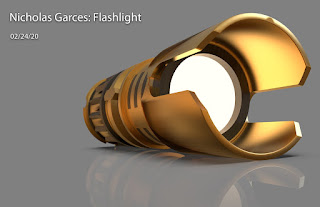Concept
For this project, I tried a different approach and decided to do some brainstorming on paper before working in Rhino. I did some sketching, and found a reference of a walking stick that gave me some inspiration for the shape and form of the 3rd hammer I sketched below. This is ultimately the one I chose because I found the shape unique, ergonomic, sleek, and minimalistic.
 |
| Ideation Sketches |
 |
| Victorian Walking Stick - Inspiration for form of the hammer |
 |
| Rhino Model with Layers |
 |
| Rhino Model Ghosted Painted Black |
 |
| Rendered Hammer Model |
 |
| Rendered Hammer Model - Perspective Shot |
Process
To make the hammer model transform from a sketch to a 3D model, I started out by perfecting a curve for the head, and a curve for the handle, and then piped the two with flat caps. I then joined the 2 and then worked on trimming the 2 ends of the pipe for the head into a shape that would be suitable for hammering. Next, I extracted a subcurve from the curve I used for the pipe, and then moved it closer to the edge where the pink silicone part would be on the handle. I then duplicated the handle and then trimmed out the pink piece from the duplicate, and then capped that with an extrusion from the subcurve, and then joined the 2 pieces back together. I repeated this for the top of the hammer as well. Next I added some chamfers at the bottom of the handle, and at the 2 sides of the hammer head.
Then it was time for rendering. After I assigned my materials and set up my environment and lighting, I took the images into Photoshop and gave more shading and highlights to the pink silicone parts, because I could not get it to look realistic enough in Keyshot. I used the dodging and burning tools in Photoshop and dropped the opacity of those adjusted layers, and changed the mode to soft light. I think the result was much more realistic looking than the 2D plastic look from before. I also toned down some of the highlights on the metal because they looked too dramatic next to the silicone's.
Materials
I wanted to keep the materials simple and straightforward, so I stuck to only 2 materials: a silicone/rubber type material, and a silver metal. For the silicone, I used a Axalta painted plastic, and added some more dimension to it with the dodging and burning tools in Photoshop to make it appear more realistic and more like silicone. The metal is a Zinc with a radial brushed texture, which I think turned out to compliment the form of this hammer well.
Materials
I wanted to keep the materials simple and straightforward, so I stuck to only 2 materials: a silicone/rubber type material, and a silver metal. For the silicone, I used a Axalta painted plastic, and added some more dimension to it with the dodging and burning tools in Photoshop to make it appear more realistic and more like silicone. The metal is a Zinc with a radial brushed texture, which I think turned out to compliment the form of this hammer well.














































